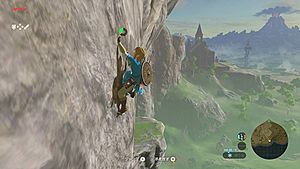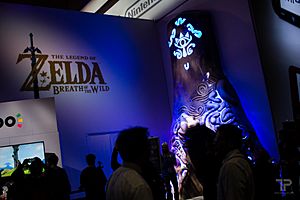The Legend of Zelda: Breath of the Wild facts for kids
Quick facts for kids The Legend of Zelda: Breath of the Wild |
|
|---|---|
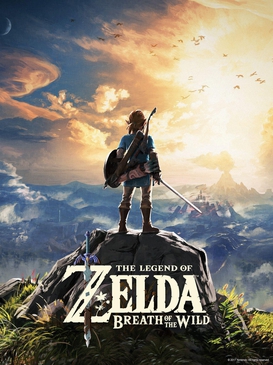
|
|
| Developer(s) | Nintendo EPD |
| Publisher(s) | Nintendo |
| Director(s) | Hidemaro Fujibayashi |
| Producer(s) | Eiji Aonuma |
| Programmer(s) |
|
| Artist(s) |
|
| Writer(s) |
|
| Composer(s) |
|
| Series | The Legend of Zelda |
| Platform(s) | |
| Release date(s) |
|
| Genre(s) | Action-adventure |
| Mode(s) | Single-player |
The Legend of Zelda: Breath of the Wild is an exciting action-adventure game made by Nintendo. It came out on March 3, 2017, for the Wii U and Nintendo Switch. An improved version for the Nintendo Switch 2 was released on June 5, 2025.
In the game, you play as Link. Your main goal is to save Princess Zelda and stop a powerful evil called Calamity Ganon from destroying the world of Hyrule. The game lets you explore a huge open world where you can find items, solve puzzles, and complete many different tasks. Breath of the Wild is special because it lets you play however you want. You don't have to follow a strict path to finish the story.
Nintendo spent five years making this game. They wanted to change how Zelda games usually worked. They added cool new features like detailed physics and chemistry systems. The creators got ideas from other games like Shadow of the Colossus and The Elder Scrolls V: Skyrim. Another company, Monolith Soft, helped design the huge landscapes.
Breath of the Wild is the best-selling Zelda game ever. It has sold over 34.51 million copies! Many people think it's one of the greatest video games of all time. It won many "Game of the Year" awards. Critics loved how it let players experiment and explore freely. It has inspired many other game creators. A spin-off game, Hyrule Warriors: Age of Calamity, came out in 2020. A direct sequel, Tears of the Kingdom, was released in 2023.
Contents
Gameplay in Hyrule
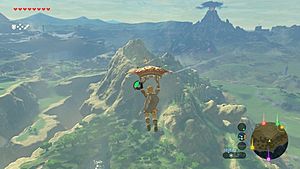
Breath of the Wild is an open-world action-adventure game. You control Link as he explores the large kingdom of Hyrule. The game lets you play in a nonlinear way. This means you can go almost anywhere you want from the start. The game doesn't give you many instructions, encouraging you to explore on your own.
A cool new feature is the game's physics engine. This means objects in the game act like they would in real life. You can solve problems in many different ways, not just one. There's also a "chemistry engine" that controls how objects interact. For example, if there's a thunderstorm, metal objects will attract lightning. You can use this to your advantage by throwing metal items at enemies! This makes the world very interactive and fun to experiment with.
As Link, you can run, climb almost anything, swim, and glide with a paraglider. Link has a limited amount of stamina for these actions. You can find items like weapons, food, and other resources. Unlike older Zelda games, weapons and shields in Breath of the Wild can break after too much use. Many items have multiple uses. For example, wooden weapons can start fires, and some shields can be used like snowboards. You can get food by hunting, gathering fruit, or collecting parts from defeated enemies. By cooking different foods together, you can make meals that heal Link or give him special powers.
Link has a special tool called the "Sheikah Slate." This magical tablet helps you mark places on your map and take pictures of things. These pictures go into your "Hyrule Compendium," which helps you find valuable items later. The Sheikah Slate also lets you create bombs, move metal objects, make ice blocks on water, and even stop certain objects in time. In fights, you can lock onto enemies for better aim. You can also defeat enemies without weapons, like by rolling boulders down hills into their camps.
Besides exploring, you can complete quests and challenges. Activating towers and shrines adds fast-travel points to your map. Towers also show you parts of the map, but you have to explore to see the names of places. Shrines are small areas with puzzles or robot battles. When you clear a shrine, you get a Spirit Orb. Collect four orbs, and you can trade them for more health or stamina. If Link has enough hearts, he can get the Master Sword from Korok Forest. This sword is special because it never truly breaks, but it needs to recharge after a lot of use.
There are also four giant mechanical animals called Divine Beasts. These are like big puzzles. All over Hyrule, you can find small puzzles that give you Korok Seeds. You can trade these seeds to make your inventory bigger for weapons, shields, and bows. Towns, villages, and horse stables are places where you can find quests, shops, and other travelers who might give you hints. You can also scan Amiibo figures with your controller to get items or even call Link's horse Epona.
The Nintendo Switch 2 version of the game has new features. It includes an extra save slot and works with "ZELDA NOTES." This service tracks your achievements, shows an interactive map, and offers voice help from Princess Zelda to find items. You can share these notes with other players.
Hyrule's Story
Breath of the Wild takes place at the end of the Zelda timeline in the kingdom of Hyrule. Long ago, a smart race called the Sheikah built an advanced civilization. They had four huge animal-like machines called Divine Beasts and an army of Guardians to protect Hyrule. When a great evil named Calamity Ganon attacked, four brave warriors, called Champions, piloted the Divine Beasts to weaken Ganon. The princess with goddess powers and her knight then sealed Ganon away.
Ten thousand years later, Hyrule had become more like a medieval kingdom. People read old prophecies and saw signs that Ganon would return. They dug up the Divine Beasts and Guardians. During this time, Princess Zelda trained hard to awaken her sealing magic. A knight named Link was chosen to protect her because he could use the Master Sword, also known as "the sword that seals the darkness." The Champions—Mipha (Zora princess), Revali (Rito archer), Daruk (Goron warrior), and Urbosa (Gerudo chief)—got ready to pilot their Divine Beasts. Zelda and Link planned to face Ganon directly.
But when Ganon appeared, he took control of the Guardians and Divine Beasts, turning them against Hyrule. King Rhoam and the Champions were killed. Much of the kingdom was destroyed. Link was badly hurt protecting Zelda. Zelda then unlocked her sealing powers, saving Link. She had Link taken to a safe place to heal. She hid the Master Sword in Korok Forest and used her magic to seal herself and Ganon in Hyrule Castle. This terrible event became known as the Great Calamity.
A hundred years later, Link wakes up in a healing chamber. He has lost his memory. He meets an old man who turns out to be the spirit of King Rhoam, Hyrule's former king. Rhoam explains that Ganon is getting stronger in Hyrule Castle. He asks Link to defeat Ganon before he breaks free and destroys the world.
Link meets Impa, a wise Sheikah elder. She tells him to free the Divine Beasts. Link travels across Hyrule, visiting places from his past and slowly getting his memories back. He boards each of the four Divine Beasts and defeats the evil inside them. This frees the spirits of the fallen Champions, who can now pilot their Divine Beasts again. After freeing them, each Champion gives Link a special ability: Mipha's Grace (healing), Revali's Gale (flight), Daruk's Protection (immunity to attacks), and Urbosa's Fury (lightning). Link gets help from Sidon (Mipha's brother), Yunobo (Daruk's descendant), Teba (a Rito warrior), and Riju (the Gerudo chief).
After getting the Master Sword from Korok Forest, Link enters Hyrule Castle to fight Ganon. The Divine Beasts weaken Ganon. After Link defeats him, Ganon turns into a giant beast called Dark Beast Ganon. Zelda gives Link the Bow of Light, which helps him weaken Ganon enough for Zelda to seal him away. This brings peace back to Hyrule, and the spirits of King Rhoam and the Champions can finally rest. Link and Zelda smile, sensing their presence.
If you find all thirteen memories in the "Captured Memories" quest, you unlock an extra scene after the credits. In this scene, Zelda says that Hyrule must be rebuilt. She and Link begin this journey together. Zelda tells Link that even though her powers might fade, she is okay with it.
Game Development
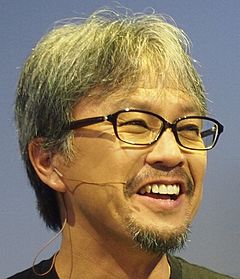
Nintendo EPD, a team within Nintendo, made Breath of the Wild for the Nintendo Switch and Wii U. The game's producer, Eiji Aonuma, said they wanted to "rethink the conventions of Zelda." Development started right after The Legend of Zelda: Skyward Sword was released in 2011. Players had told Aonuma they wanted a more connected map to explore. In 2013, Nintendo tried out nonlinear gameplay in The Legend of Zelda: A Link Between Worlds, which players really liked.
At E3 2014, Aonuma said he planned to change how dungeons and puzzles worked. He wanted players to be able to reach the end of the game without having to follow the story in a strict order. Since Nintendo had never made such a big open-world game, they looked at games like The Elder Scrolls V: Skyrim and Shadow of the Colossus for ideas. For the game's art style, the team was inspired by Japanese anime they watched growing up, possibly including Studio Ghibli films. Link, the main character, was redesigned to be more gender neutral so more players could feel connected to him.
Before making the full game, the developers created a simple 2D version. This helped them test out physics-based puzzles. The final game uses a special Havok physics engine. At the 2017 Game Developers Conference, director Hidemaro Fujibayashi showed this early version. Aonuma said the physics engine was a huge step for the Zelda series. He explained that it makes everything in the world act in a "logical and realistic way." This allows players to solve problems in many different ways. He also shared a funny story about how, during development, he once found all the objects in a game area had been blown away by the wind!
Early on, the game was going to have "double hookshots." These would let Link swing around like Spider-Man. But this idea was removed because it gave Link too much freedom and made the climbing feature less important. The team realized that adding too many actions for Link would make the controls too complicated. Instead, they focused on making the world itself more interactive.
The game was first designed with touchscreen features for the Wii U. However, the developers found that looking back and forth between the Wii U GamePad and the TV screen was distracting. These features were removed when the game was made for both the Switch and Wii U. The Wii U GamePad also influenced Link's design. In older games, Link was left-handed, but in Breath of the Wild, he is right-handed to match the GamePad's controls. The Switch version of the game looks better when connected to a TV. When played handheld, both the Switch and Wii U versions have the same picture quality. The Switch version also has better environmental sounds. Some ideas, like flying and underground dungeons, were not put into the game because of the Wii U's limits. These ideas were saved for the sequel.
Aonuma said the art style was inspired by gouache paintings and outdoor art. This helped show how vast the world was. The game's landscape was based on places around Kyoto, the director's hometown. Monolith Soft helped design the land. The first area you play in was made as a plateau so players could see the huge world around them.
Breath of the Wild was the first main Zelda game to use voice acting in its story scenes. Link, however, remains a silent protagonist. Aonuma was very impressed the first time he heard a character speak in the game. He wanted players to feel the same way. The team decided to record voices for all story scenes, not just the most important ones. Nintendo provided voices and subtitles in eight different languages. Later, in May 2017, an update allowed players to choose different languages for voices and subtitles. After five years of work, the game was finished. A five-disc soundtrack with 211 songs was released in Japan on April 25, 2018.
Game Release
Aonuma first announced the game for the Wii U in January 2013. He said it would challenge the usual rules of the Zelda series. The next year, Nintendo showed off the game's high-definition, cel-shaded art style at their E3 event. The game was first planned for release in 2015 but was delayed. It was delayed again in April 2016 due to issues with its physics system. In June 2016, Nintendo let people play the Wii U version at the E3 convention. There, they also announced its full title: Breath of the Wild. Many publications listed it as one of the best games at E3 that year.
Breath of the Wild launched for both the Wii U and Switch on March 3, 2017. It was the very last Nintendo game released for the Wii U. The Switch version was available in special bundles. These included a coin, a tapestry map, a soundtrack CD, and a carrying case for the Switch. A "Master Edition" also came with a Master Sword figurine. An "Explorer's Edition" for the Switch was released on November 23, 2017. It included a map and a book with story information.
An improved version of the game for the Nintendo Switch 2 was released on June 5, 2025. This version has better picture quality, smoother gameplay, and supports HDR (High-Dynamic-Range) colors. It also works with the Nintendo Switch Online app for extra features.
Extra Content
In 2017, Nintendo released two packs of downloadable content (DLC) called an "expansion pass." These were The Master Trials and The Champions' Ballad.
The Master Trials was released in June 2017. It added new ways to play, features, and items. The "Trial of the Sword" challenge makes you fight through many rooms of enemies without any equipment. If you lose, you start over! Completing these trials makes your Master Sword stronger. This pack also added a harder difficulty called Master Mode. In this mode, enemies are tougher, notice Link more easily, and slowly heal during battle. New floating platforms appeared with enemies and treasure. The "Hero's Path" feature shows where you've traveled on the map, helping you find places you haven't visited. You could also find a Travel Medallion to save a special fast-travel point anywhere you wanted. New items included the Korok Mask, which tells you when a Korok is nearby.
The Champions' Ballad was released in December 2017. This DLC added a new dungeon, more story content, new gear, and extra challenges. After finishing its quest line, Link could even ride a motorcycle-like vehicle called the Master Cycle Zero!
A complete "Expansion Pass" edition, with all the DLC on the game card, was released only in Japan on October 8, 2021.
Game's Impact
It's been three long years since The Legend of Zelda: Breath of the Wild rewired the connections inside my brain. It messed me up. In some ways you might say it ruined video games. Other video games. [...] It's not God of War's fault that it's not Breath of the Wild. It's not Spider-Man's fault that it's not Breath of the Wild. I spent a good 10 hours playing Red Dead Redemption 2, hoping it was Breath of the Wild, then eventually gave up. No one's fault. Sorry, other video games. You tried, but you weren't Breath of the Wild.
After Breath of the Wild came out, many people in the video game world talked about how it would change future open-world games. Benjamin Plich, a designer for Assassin's Creed Unity, said he believed game makers would learn from its focus on letting players experiment freely. Damien Monnier, a designer for The Witcher 3: Wild Hunt, noted that Breath of the Wild brought together classic open-world ideas without forcing players to follow them. This encouraged players to explore on their own.
The game's "reactive physics" design was called "a revelation for the open world genre" by Screen Rant. It was also praised for its experimental chemistry engine, which was just as important as the physics. PC Gamer wrote that the game set a new standard for its type and for future games. It has been listed as the best game of all time by IGN and GQ.
Many games and developers have said Breath of the Wild was an inspiration. These include Genshin Impact, Ghost of Tsushima, Eternal Strands, Immortals Fenyx Rising, Telling Lies, Halo Infinite, Elden Ring, and Forspoken. People have also noticed similarities between Breath of the Wild and other open-world games released since, like Pokémon Legends: Arceus, Sonic Frontiers, and Horizon Forbidden West. Digital Trends said that Breath of the Wild has become a popular game to compare other open-world games to.
The game's success also made people more interested in the Wii U emulator Cemu. The Cemu developers quickly updated their software so Breath of the Wild could run smoothly on it. This led to a big modding community for the game.
Hyrule Warriors: Age of Calamity is a spin-off game that came out on November 20, 2020, for the Nintendo Switch. It's a hack and slash game that tells a story set 100 years before Breath of the Wild.
Game Sequel
A sequel, called The Legend of Zelda: Tears of the Kingdom, was released on May 12, 2023. Hidemaro Fujibayashi returned as the director. The idea for the sequel came about when they were planning extra content for Breath of the Wild. The team had so many ideas that they decided to make a whole new game. The sequel builds on the original game's world with a new story and gameplay. It was partly inspired by Red Dead Redemption 2.
See also
 In Spanish: The Legend of Zelda: Breath of the Wild para niños
In Spanish: The Legend of Zelda: Breath of the Wild para niños


